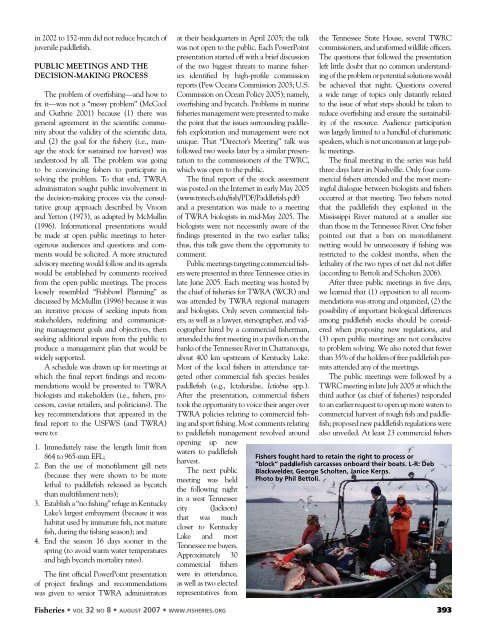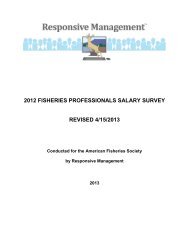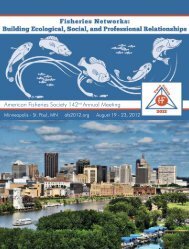Conservation Status of Crayfish Species Paddlefish Conservation ...
Conservation Status of Crayfish Species Paddlefish Conservation ...
Conservation Status of Crayfish Species Paddlefish Conservation ...
Create successful ePaper yourself
Turn your PDF publications into a flip-book with our unique Google optimized e-Paper software.
in 2002 to 152-mm did not reduce bycatch <strong>of</strong><br />
juvenile paddlefish.<br />
puBLiC meetingS and the<br />
deCiSiOn-maKing prOCeSS<br />
The problem <strong>of</strong> overfishing—and how to<br />
fix it—was not a “messy problem” (McCool<br />
and guthrie 2001) because (1) there was<br />
general agreement in the scientific community<br />
about the validity <strong>of</strong> the scientific data,<br />
and (2) the goal for the fishery (i.e., manage<br />
the stock for sustained roe harvest) was<br />
understood by all. The problem was going<br />
to be convincing fishers to participate in<br />
solving the problem. To that end, TWRA<br />
administrators sought public involvement in<br />
the decision-making process via the consultative<br />
group approach described by Vroom<br />
and Yetton (1973), as adapted by McMullin<br />
(1996). Informational presentations would<br />
be made at open public meetings to heterogenous<br />
audiences and questions and comments<br />
would be solicited. A more structured<br />
advisory meeting would follow and its agenda<br />
would be established by comments received<br />
from the open public meetings. The process<br />
loosely resembled “Fishbowl Planning” as<br />
discussed by McMullin (1996) because it was<br />
an iterative process <strong>of</strong> seeking inputs from<br />
stakeholders, redefining and communicating<br />
management goals and objectives, then<br />
seeking additional inputs from the public to<br />
produce a management plan that would be<br />
widely supported.<br />
A schedule was drawn up for meetings at<br />
which the final report findings and recommendations<br />
would be presented to TWRA<br />
biologists and stakeholders (i.e., fishers, processors,<br />
caviar retailers, and politicians). The<br />
key recommendations that appeared in the<br />
final report to the USFWS (and TWRA)<br />
were to:<br />
1. Immediately raise the length limit from<br />
864 to 965-mm EFL;<br />
2. Ban the use <strong>of</strong> mon<strong>of</strong>ilament gill nets<br />
(because they were shown to be more<br />
lethal to paddlefish released as bycatch<br />
than multifilament nets);<br />
3. Establish a “no fishing” refuge in Kentucky<br />
Lake’s largest embayment (because it was<br />
habitat used by immature fish, not mature<br />
fish, during the fishing season); and<br />
4. End the season 16 days sooner in the<br />
spring (to avoid warm water temperatures<br />
and high bycatch mortality rates).<br />
The first <strong>of</strong>ficial PowerPoint presentation<br />
<strong>of</strong> project findings and recommendations<br />
was given to senior TWRA administrators<br />
at their headquarters in April 2005; the talk<br />
was not open to the public. Each PowerPoint<br />
presentation started <strong>of</strong>f with a brief discussion<br />
<strong>of</strong> the two biggest threats to marine fisheries<br />
identified by high-pr<strong>of</strong>ile commission<br />
reports (Pew Oceans Commission 2003; U.S.<br />
Commission on Ocean Policy 2005); namely,<br />
overfishing and bycatch. Problems in marine<br />
fisheries management were presented to make<br />
the point that the issues surrounding paddlefish<br />
exploitation and management were not<br />
unique. That “director’s Meeting” talk was<br />
followed two weeks later by a similar presentation<br />
to the commissioners <strong>of</strong> the TWRC,<br />
which was open to the public.<br />
The final report <strong>of</strong> the stock assessment<br />
was posted on the Internet in early May 2005<br />
(www.tntech.edu/fish/PdF/<strong>Paddlefish</strong>.pdf)<br />
and a presentation was made to a meeting<br />
<strong>of</strong> TWRA biologists in mid-May 2005. The<br />
biologists were not necessarily aware <strong>of</strong> the<br />
findings presented in the two earlier talks;<br />
thus, this talk gave them the opportunity to<br />
comment.<br />
Public meetings targeting commercial fishers<br />
were presented in three Tennessee cities in<br />
late June 2005. Each meeting was hosted by<br />
the chief <strong>of</strong> fisheries for TWRA (WCR) and<br />
was attended by TWRA regional managers<br />
and biologists. Only seven commercial fishers,<br />
as well as a lawyer, stenographer, and videographer<br />
hired by a commercial fisherman,<br />
attended the first meeting in a pavilion on the<br />
banks <strong>of</strong> the Tennessee River in Chattanooga,<br />
about 400 km upstream <strong>of</strong> Kentucky Lake.<br />
Most <strong>of</strong> the local fishers in attendance targeted<br />
other commercial fish species besides<br />
paddlefish (e.g., Ictaluridae, Ictiobus spp.).<br />
After the presentation, commercial fishers<br />
took the opportunity to voice their anger over<br />
TWRA policies relating to commercial fishing<br />
and sport fishing. Most comments relating<br />
to paddlefish management revolved around<br />
opening up new<br />
waters to paddlefish<br />
harvest.<br />
The next public<br />
meeting was held<br />
the following night<br />
in a west Tennessee<br />
city (Jackson)<br />
that was much<br />
closer to Kentucky<br />
Lake and most<br />
Tennessee roe buyers.<br />
Approximately 30<br />
commercial fishers<br />
were in attendance,<br />
as well as two elected<br />
representatives from<br />
the Tennessee State House, several TWRC<br />
commissioners, and uniformed wildlife <strong>of</strong>ficers.<br />
The questions that followed the presentation<br />
left little doubt that no common understanding<br />
<strong>of</strong> the problem or potential solutions would<br />
be achieved that night. Questions covered<br />
a wide range <strong>of</strong> topics only distantly related<br />
to the issue <strong>of</strong> what steps should be taken to<br />
reduce overfishing and ensure the sustainability<br />
<strong>of</strong> the resource. Audience participation<br />
was largely limited to a handful <strong>of</strong> charismatic<br />
speakers, which is not uncommon at large public<br />
meetings.<br />
The final meeting in the series was held<br />
three days later in Nashville. Only four commercial<br />
fishers attended and the most meaningful<br />
dialogue between biologists and fishers<br />
occurred at that meeting. Two fishers noted<br />
that the paddlefish they exploited in the<br />
Mississippi River matured at a smaller size<br />
than those in the Tennessee River. One fisher<br />
pointed out that a ban on mon<strong>of</strong>ilament<br />
netting would be unnecessary if fishing was<br />
restricted to the coldest months, when the<br />
lethality <strong>of</strong> the two types <strong>of</strong> net did not differ<br />
(according to Bettoli and Scholten 2006).<br />
After three public meetings in five days,<br />
we learned that (1) opposition to all recommendations<br />
was strong and organized, (2) the<br />
possibility <strong>of</strong> important biological differences<br />
among paddlefish stocks should be considered<br />
when proposing new regulations, and<br />
(3) open public meetings are not conducive<br />
to problem solving. We also noted that fewer<br />
than 35% <strong>of</strong> the holders <strong>of</strong> free paddlefish permits<br />
attended any <strong>of</strong> the meetings.<br />
The public meetings were followed by a<br />
TWRC meeting in late July 2005 at which the<br />
third author (as chief <strong>of</strong> fisheries) responded<br />
to an earlier request to open up more waters to<br />
commercial harvest <strong>of</strong> rough fish and paddlefish;<br />
proposed new paddlefish regulations were<br />
also unveiled. At least 23 commercial fishers<br />
Fishers fought hard to retain the right to process or<br />
“block” paddlefish carcasses onboard their boats. L-r: deb<br />
blackwelder, george Scholten, Janice kerns.<br />
Photo by Phil bettoli.<br />
Fisheries • vol 32 no 8 • august 2007 • www.fisheries.org 393







